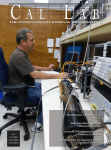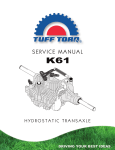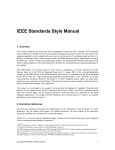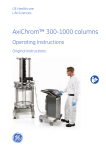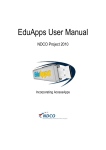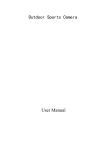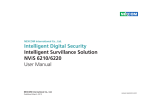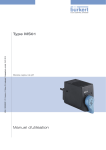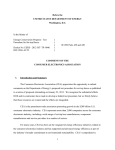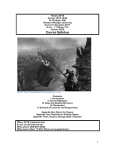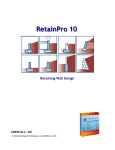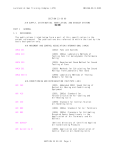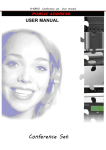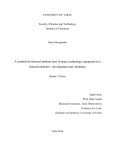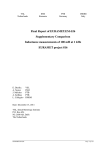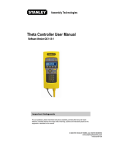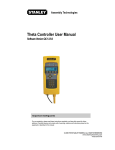Download NCSL International Technical Publications Style Guide
Transcript
NCSL International Technical Publications Style Guide First Edition - Feb 2013 Prepared by: NCSL International - Publications Oversight Committee Copyright © 2013 by NCSL International All rights reserved. Publisher NCSL International 2995 Wilderness Place, Suite 107 Boulder, CO 80301 Phone: (303) 440-3339 Fax: (303) 440-3384 Email: [email protected] Vision To be the Recognized Leader for Excellence in Measurement Science Mission • Invest in the Advancement of Measurement Science • Promote Education and Skill Development • Provide Tools and Resources to Enhance Member Processes • Drive Technical Integrity in Documentary Standards NCSL International Style Guide 2013 Abstract This style guide provides editorial guidance to the authors of NCSL International publications, including catalogs, documentary standards, guides and manuals, handbooks, reference publications, recommend intrinsic and derived standard practices (RISPs), and recommend practice guides (RPs). Guidance is provided for all aspects of the content of these documents. Adherence to the style and formatting conventions outlined in this guide ensures that NCSLI publications will maintain high quality standards, and will have a consistent format that makes them easily accessible to the reader. Acknowledgements The first edition of this style guide was developed by the Publications Oversight Committee and NCSLI Business Office in collaboration with NCSLI committee chair review. Key members include: Name Organization Michael Lombardi (Chair) Tim Osborne (Board Member) Del Caldwell Craig Gulka National Institute of Standards and Technology Dynamic Technology, Trescal Caldwell Consulting Group NCSL International Introduction This NCSL International Technical Publications Style Guide is largely based on The Chicago Manual of Style. It provides style guidelines that if followed properly by authors, will allow all NCSLI standards documents to have a consistent format and be easily accessible to readers. It was also designed to give NCSLI technical publications a simultaneous print and electronic publishing model, so that electronic versions of NCSLI technical publications can emulate the organization and structure of their printed-and-bound counterparts. Table 1 — Publication Structure FRONT MATTER BODY TEXT BACK MATTER Cover Title page & copyright page Abstract Acknowledgement of contributors and company affiliation Table of Contents Introduction First text page -Scope -Content -References -Terms and definitions Illustration credits (if not in captions or elsewhere) Abbreviations and acronyms Glossary Bibliography Appendix(s) Chronology Notes Permissions and Disclaimers Summary of Changes NCSLI technical publications are organized into three major divisions the front matter (also called preliminary matter, or prelims,) the text and the back matter (or end matter). The front matter presents information about the publication's title, publisher, and copyright and provides a way to navigate the structure of the publication. The text proper comprises the narrative—including arguments, data, illustrations, and so forth—often divided into clauses and other meaningful NCSLI Style Guide (Approved 2-4-13) ii NCSL International Style Guide 2013 subclauses. The back matter presents sources, source notes, appendices, and other types of documentation supporting the text but outside its central focus or narrative. The list that follows presents the traditional arrangement, using lowercase Roman numerals for pages in the front matter and Arabic numerals for all the rest, including the back matter. Every page is counted in the page sequence, even those on which no number actually appears, such as the title and half-title pages, copyright page. NCSLI Style Guide (Approved 2-4-13) iii NCSL International Style Guide 2013 Table of Contents ABSTRACT .................................................................................................................................................... II ACKNOWLEDGEMENTS ................................................................................................................................ II INTRODUCTION ........................................................................................................................................... II 1. SCOPE .................................................................................................................................................. 1 2. REFERENCES ........................................................................................................................................ 1 3. TERMS AND DEFINITIONS .................................................................................................................... 1 3.1 CATALOG............................................................................................................................................... 1 3.2 DOCUMENTARY STANDARDS ..................................................................................................................... 1 3.3 GUIDES AND MANUALS ............................................................................................................................ 1 3.4 HANDBOOKS .......................................................................................................................................... 2 3.5 LABORATORY MANAGEMENT (LM) ............................................................................................................ 2 3.6 RECOMMENDED INTRINSIC & DERIVED STANDARD PRACTICE (RISPS) ............................................................... 2 3.7 RECOMMENDED PRACTICE (RP) ................................................................................................................ 2 3.8 REFERENCE PUBLICATIONS ........................................................................................................................ 2 4. COPYRIGHT AND PERMISSIONS ........................................................................................................... 3 4.1 GENERAL COPYRIGHT POLICY ..................................................................................................................... 3 4.2 EXCERPTS .............................................................................................................................................. 3 4.3 CREDIT LINE ........................................................................................................................................... 3 5. TRADEMARKS ...................................................................................................................................... 3 5.1 USE OF TRADEMARKS ............................................................................................................................... 3 5.2 NCSLI TRADEMARKS ............................................................................................................................... 3 6. COMMERCIAL TERMS AND CONDITIONS ............................................................................................. 3 6.1 GENERAL ............................................................................................................................................... 3 6.2 CITATION............................................................................................................................................... 4 7. FRONT MATTER ................................................................................................................................... 4 7.1 REQUIRED FRONT MATTER ELEMENTS .......................................................................................................... 4 7.2 DRAFT LABELING AND DESIGNATIONS .......................................................................................................... 4 7.3 DRAFT COPYRIGHT STATEMENTS................................................................................................................. 5 7.4 COPYRIGHT RENEWAL OR OTHER CHANGES. .................................................................................................. 5 7.5 EDITION ................................................................................................................................................ 5 7.6 AMENDMENTS AND ERRATA SHEETS ........................................................................................................... 6 7.7 TITLE .................................................................................................................................................... 6 7.8 ABSTRACT.............................................................................................................................................. 6 7.9 INTRODUCTION ....................................................................................................................................... 6 7.10 ACKNOWLEDGEMENTS ............................................................................................................................. 7 7.11 TABLE OF CONTENTS ................................................................................................................................ 7 8. DRAFT PUBLICATION BODY ................................................................................................................. 7 8.1 GENERAL ............................................................................................................................................... 7 8.1.1 Normative and informative clauses ............................................................................................... 7 8.1.2 Word usage.................................................................................................................................... 8 8.2 OVERVIEW........................................................................................................................................... 10 8.2.1 General ........................................................................................................................................ 10 8.2.2 Scope............................................................................................................................................ 10 8.2.3 Purpose ........................................................................................................................................ 10 8.2.4 Citations ....................................................................................................................................... 11 8.3 REFERENCES......................................................................................................................................... 11 8.4 TERMS AND DEFINITIONS ........................................................................................................................ 11 8.4.1 General terminology usage.......................................................................................................... 11 8.4.2 Construction of the definitions clause.......................................................................................... 11 NCSLI Style Guide (Approved 2-4-13) iv NCSL International Style Guide 2013 8.5 ACRONYMS AND ABBREVIATIONS ..................................................................................................................... 11 8.5.1 General ........................................................................................................................................ 11 8.5.2 Exceptions .................................................................................................................................... 12 9. NUMBERING THE CLAUSES AND SUBCLAUSES OF A PUBLICATION .....................................................12 9.1 BODY CLAUSES ..................................................................................................................................... 12 9.2 NUMBERING APPENDICES ....................................................................................................................... 13 9.3 LISTS .................................................................................................................................................. 13 10. QUANTITIES, UNITS, AND LETTER SYMBOLS .......................................................................................13 10.1 QUANTITY ........................................................................................................................................... 13 10.2 NUMBERS............................................................................................................................................ 14 10.3 METRIC SYSTEM.................................................................................................................................... 14 10.4 LETTER SYMBOLS................................................................................................................................... 14 10.5 HYPERLINKS ........................................................................................................................................ 15 11. TABLES ...............................................................................................................................................15 11.1 LABELING AND PRESENTATION OF TABLES ................................................................................................... 15 11.2 NUMBERING AND CAPITALIZATION IN TABLES .............................................................................................. 15 11.3 PRESENTATION OF DATA AND TABLE FORMAT.............................................................................................. 16 11.3.1 Units of measure ..................................................................................................................... 16 11.3.2 Numerical values ..................................................................................................................... 16 11.4 NOTES AND FOOTNOTES TO TABLES .......................................................................................................... 16 11.5 INFORMAL TABLES ................................................................................................................................. 17 11.6 TABLE PREPARATION .............................................................................................................................. 17 11.6.1 Consistency among tables ...................................................................................................... 17 11.6.2 Table structure and use ........................................................................................................... 17 11.6.3 Horizontal and vertical rules ................................................................................................... 18 12. FIGURES ..............................................................................................................................................18 12.1 REQUIREMENTS FOR CREATING FIGURES .................................................................................................... 18 12.2 FIGURE NUMBERING AND TITLES............................................................................................................... 18 12.3 NOTES AND FOOTNOTES TO FIGURES ......................................................................................................... 18 13. MATHEMATICAL EXPRESSIONS ...........................................................................................................19 13.1 LETTER SYMBOLS AND UNITS.................................................................................................................... 19 13.2 NUMBERING OF EQUATIONS.................................................................................................................... 19 13.3 PRESENTATION OF EQUATIONS................................................................................................................. 19 13.4 QUANTITY AND NUMERICAL VALUE EQUATIONS ........................................................................................... 20 14. NOTES, FOOTNOTES, EXAMPLES, WARNINGS, AND CAUTIONS ..........................................................21 14.1 NOTES ................................................................................................................................................ 21 14.2 FOOTNOTES ......................................................................................................................................... 21 14.3 EXAMPLES ........................................................................................................................................... 21 14.4 WARNINGS AND CAUTIONS ..................................................................................................................... 22 14.5 FOOTNOTES VERSUS ENDNOTES ............................................................................................................... 22 14.5.1 Footnotes and endnotes - an overview ................................................................................... 22 14.5.2 Footnotes—pros and cons ....................................................................................................... 22 14.5.3 Endnotes—pros and cons ........................................................................................................ 22 14.5.4 Special needs of endnotes ....................................................................................................... 22 14.5.5 Avoiding overlong notes .......................................................................................................... 23 BACK MATTER .............................................................................................................................................23 15. BIBLIOGRAPHY ...................................................................................................................................23 15.1 GENERAL ............................................................................................................................................. 23 15.1.1 Relationship of bibliographies to notes ................................................................................... 23 15.2 CITING STANDARDS IN A BIBLIOGRAPHY ..................................................................................................... 24 15.3 ARTICLES IN PERIODICALS ............................................................................................................................. 24 15.4 BOOKS ................................................................................................................................................ 24 15.4.1 Other types of bibliographies .................................................................................................. 25 15.4.2 Annotated bibliography........................................................................................................... 25 NCSLI Style Guide (Approved 2-4-13) v NCSL International Style Guide 2013 15.4.3 Articles in corporate reports .................................................................................................... 25 15.4.4 Articles presented at conferences ........................................................................................... 25 15.4.5 Government publications ........................................................................................................ 25 15.4.6 Uniform resource locators (URLs) ............................................................................................ 26 15.4.7 Theses, dissertations, and other unpublished works ............................................................... 26 16. AMENDMENTS, CORRIGENDA, AND ERRATA ......................................................................................26 16.1 GENERAL ............................................................................................................................................. 26 16.2 AMENDMENTS AND CORRIGENDA ............................................................................................................. 26 16.2.1 Numbering in amendments and corrigenda ........................................................................... 27 16.2.2 Editorial instructions in amendments and corrigenda ............................................................ 27 16.2.3 Amendment versus revision .................................................................................................... 28 17. PERMISSIONS AND DISCLAIMERS .......................................................................................................28 17.1 PERMISSION TO REPRODUCE.................................................................................................................... 28 17.2 SUMMARY OF CHANGES ......................................................................................................................... 29 18. FORMATTING .....................................................................................................................................29 18.1 FONTS: ............................................................................................................................................... 29 18.2 MARGINS/SPACING:.............................................................................................................................. 30 18.3 TABLES/FIGURES:.................................................................................................................................. 30 18.4 BULLETS: ............................................................................................................................................. 30 18.5 OUTLINING: ......................................................................................................................................... 30 18.6 HEADERS/FOOTERS: .............................................................................................................................. 30 APPENDIX A. PROCESS FLOW CHART ..........................................................................................................31 NCSLI Style Guide (Approved 2-4-13) vi NCSL International Style Guide 2013 1. Scope This Style Guide establishes preferred style for the presentation and structure of all NCSLI technical publications defined in clause 3. This 2013 edition of the Style Guide is applicable to all drafts submitted for approval after February 2013. 2. References The following documents are essential resources for writing an NCSLI Technical Publication. Consult the most recent version of undated sources. The Chicago Manual of Style. Chicago: The University of Chicago Press. Available at www.chicagomanualofstyle.org/home.html Merriam-Webster’s New Collegiate Dictionary. Springfield, MA: Merriam-Webster, Inc. Available at www.merriam-webster.com International Vocabulary of Metrology – Basic and General Concepts and Associated Terms JCGM 200:2012 Available from: www.bipm.org/en/publications/guides/vim.html Guide for the Use of the International System of Units (SI), NIST Special Publication 811, 2008. Available from: www.nist.gov/pml/pubs/sp811/index.cfm BIPM, The International System of Units (SI), 8th edition, 2006. Available from: www.bipm.org/en/si/si_brochure/general.html 3. Terms and definitions 3.1 Catalog NCSLI catalogs are compilations of resources or reference information. Catalogs may be in printed form, or if compiled electronically, they may be in a form of a database. NCSLI catalogs can contain (but are not limited to) listings of intrinsic and derived standards, lists of training courses, or lists of laboratories offering capabilities in a given metrological area. 3.2 Documentary Standards The NCSLI ASC Z540 Committee is the accredited committee to develop, write and publish metrology related ANSI documentary standards and adopt ISO, IEC and other standards. The Committee is comprised of representatives from industry and government sectors and includes stakeholders that may be affected by the standards. Documentary standards follow the style and format requirements of ANSI guidelines, but may include NCSLI style and format requirements when not in conflict with ANSI. 3.3 Guides and Manuals NCSLI Guides and Manuals are internal publications used within the organization by the NCSLI membership. They contain non-technical information and document the operation, guidelines, procedures, NCSLI Style Guide (Approved 2-4-13) Page 1 NCSL International Style Guide 2013 and policies of NCSLI. Topics covered by NCSLI guides can include (but are not limited to): guidelines, procedures, and policies for the board of directors, handbooks for committee chairs, policies for NCSLI writing groups, and handbooks for regional or section coordinators. 3.4 Handbooks NCSLI handbook publications are prepared to facilitate the understanding and implementation of metrology related national or international standards. Handbooks may include descriptive information, theory, recommended methods and techniques and an extended bibliography that the related committee thought would save individual users time and improve their usage of the related standard. 3.5 Laboratory Management (LM) NCSLI Laboratory Management (LM) publications are guides and handbooks normally used by management for the daily operation of a calibration or test laboratory. These publications tend to focus on management related issues. Topics covered by LM publications include (but are not limited to) achieving laboratory accreditation, interpreting accreditation standards, and evaluating laboratory personnel. 3.6 Recommended Intrinsic & Derived Standard Practice (RISPs) NCSLI RISP publications provide recommended practices for the maintenance and operation of reference standards for a specific area of metrology, such as voltage standards, for example. RISP publications are written by NCSLI committees that consist of metrology engineering professionals. A high percentage of committee members are subject matter experts in the specific area of metrology being covered. 3.7 Recommended Practice (RP) NCSLI Recommended Practice (RP) - publications provide information and technical guidance to organizations associated with metrology, calibration, measurement, and testing. RP publications are written by NCSLI Committees and Working Groups that consist of metrology experts employed by organizations in both the public and private sectors. The RP series of documents are developed to recommend and describe contemporary best practices that are currently being successfully implemented. Adherence to these practices will help ensure the uniformity of measurements across organizations. Topics covered by RP publications include (but are not limited to) calibration procedures, equipment selection, interlaboratory comparisons, laboratory design, and measurement uncertainty analysis. 3.8 Reference Publications NCSLI reference publications are collections of books or other sources to which one is directed or referred for further related information in the field of Metrology. They are designed to provide a comprehensive listing of Metrology-related material in one place, so that items can be quickly “looked up” when necessary. Topics include (but are not limited to) glossaries, and lists of acronyms and abbreviations. NCSLI Style Guide (Approved 2-4-13) Page 2 NCSL International Style Guide 2013 4. Copyright and Permissions 4.1 General copyright policy Contributions by participants to NCSLI Publications projects are subject to the NCSLI copyright policy. 4.2 Excerpts When using excerpts of published text, tables, or figures, permission in writing to do so shall be obtained from the copyright owner with an applicable credit line. NOTE: Committee Working Groups are encouraged to request permission from copyright owners before including copyrighted material in a draft. Committee Chair should initiate the permissionseeking process prior to the start of initial publications ballot. If excerpted material is inserted during ballot resolution, receipt of permission letters will be required before the recirculation ballot of the draft. If there are difficulties with obtaining permission responses, the Working Group should consider citing the information normatively rather than including an excerpt. 4.3 Credit line The following credit line shall be used if specific language from the copyright holder is not available: <Indicate material> reprinted from <copyright owner, title of publication, year of publication.> 5. Trademarks 5.1 Use of trademarks Use of trademarks should be minimized. When used, trademarks shall be appropriate for their drafts and ensure that no fees are required, limitations imposed, etc. This information is usually stated on the websites of the trademark owners. Any trademarked items shall be identified in the publication and marked as such (with either ® or ™), as appropriate, upon first reference. All trademarked items cited in publications shall be credited to the trademark owner in the front matter of the publication. 5.2 NCSLI trademarks NCSLI designations are trademarks of the NCSLI and shall be identified as trademarks ™ appropriate at first citation of each designation in the front matter and in the body of the draft. 6. Commercial terms and conditions 6.1 General Provisions involving business relations between buyer and seller such as guarantees, warranties, and other commercial terms and conditions shall not be included in NCSLI publications. Publications should not endorse, or appear to endorse, any particular products, services, or companies. Therefore, it generally is not acceptable to include manufacturer lists, service provider lists, or similar material in the text of an NCSLI publication. Where a sole source exists for essential equipment, materials, or services necessary to comply with or to determine compliance with the publication, it is permissible to supply the name and NCSLI Style Guide (Approved 2-4-13) Page 3 NCSL International Style Guide 2013 address of the source in a footnote as long as the words “or the equivalent” are added to the reference. 6.2 Citation Citation of a product, service or company shall be avoided. In those cases where a sole source exists, the product, service or company shall be described generically in text and the product, service or company supplied in a footnote accompanying the text, as follows: At the time of this publication [product, service or company] was an example of [name of generic product, etc.]. This information is given for the convenience of users of this publication and does not constitute an endorsement by the NCSLI of these products. Equivalent products may be used if they can be shown to provide comparable results. If every effort has been made to substitute a generic word or phrase in text for the product, service or company, but no suitable substitute can be found, add the following footnote to accompany the citation: This information is given for the convenience of users of this publication and does not constitute an endorsement by the NCSLI of these products. Equivalent products may be used if they can be shown to lead to the same results. In addition to the above footnote, within the text add “or the equivalent” after the name of the product, service or company. For example, “…use an ABC, or the equivalent, to monitor…” 7. Front matter 7.1 Required front matter elements The front matter of an NCSLI publication is informative, meaning it is not officially part of the technical guidance or related information provided by the publication. Drafts should contain a front matter and main text, and follow the style outlined in this guide. The front matter is paginated separately from the body of the draft. The front matter is paginated using Roman numerals, e.g., i, ii, iii, etc. The body of the draft is paginated with Arabic numerals, e.g., 1, 2, 3, etc. Front matter elements are required in the draft prior to going to ballot, plus the designation, the title of the publication, the introduction, and copyright statements. A notice to users (laws and regulations, copyrights, updating of NCSLI documents, errata, interpretations), is also required. 7.2 Draft labeling and designations All drafts shall be clearly labeled to reflect their status as unapproved publications. The draft designation and the date of the draft shall appear in the upper right corner of each page of the draft. The designation and date shall not be combined. The NCSLI publication designation shall be structured as (Document Nomenclature) (Draft Designator). Draft versions shall be maintained, and are most important during a ballot; the draft number should be updated as least as often as the document is modified and/or recirculated, e.g. 1.1, 1.2, 1.3, etc. Draft designations should indicate the development stage as follows: NCSLI Style Guide (Approved 2-4-13) Page 4 NCSL International Style Guide 2013 ED: Exploratory Draft WD: Working Draft RD: Revision Draft FD: Final Draft Example: 7.3 NCSLI RP-XX WD 1.0 Draft copyright statements All NCSLI drafts are to include statements of copyright. The following information shall appear on the first page of every NCSLI Publication draft: NOTE: The placeholder <201X> shall be replaced with the current year of distribution. Copyright © 201X by NCSL International 2995 Wilderness Place, Suite 107 Boulder, CO 80301, USA All rights reserved. This document is an unapproved draft of a proposed NCSLI publication. As such, this document is subject to change. USE AT YOUR OWN RISK! Because this is an unapproved draft, this document must not be utilized for any conformance/compliance purposes. Permission is hereby granted for NCSLI Committee participants to reproduce this document for purposes of consideration. Prior to adoption of this document, in whole or in part, permission must first be obtained from the NCSLI. Other entities seeking permission to reproduce this document, in whole or in part, must also obtain permission from the NCSLI. The following information shall appear on every page of the draft, at the bottom of the page: Copyright © <201X> NCSLI. All rights reserved. This is an unapproved NCSL International Publication Draft, subject to change. 7.4 Copyright renewal or other changes. The date of copyright renewal or a change in the name of the copyright owner is sometimes reflected in the copyright notice if the work is reprinted. Copyright renewal is shown in the following manner: © 1943 by Miriam Obermerker. © renewed 1971 by Miriam Obermerker. 7.5 Edition Edition (as opposed to impression or printing) is used in at least two senses. • A new edition may be defined as one in which a substantial change has been made in one or more of the essential elements of the work (e.g., text, notes, appendix, or illustrations). As a general rule, at least 20 percent of a new edition should consist of new or revised material. A work that is republished with a new Preface or Afterword but is otherwise unchanged except for corrections of typographical errors is better described as a new impression or a reissue; the title page may NCSLI Style Guide (Approved 2-4-13) Page 5 NCSL International Style Guide 2013 • 7.6 include such words as "With a New Preface." Edition may be used to designate a reissue in a different format —for example, a paperback, deluxe, or illustrated version, or an electronic edition of a printed work— or under the imprint of a different publisher. A new edition is best designated on the Title page: Second Edition, Third Edition, and so forth. Such phrases as "revised and expanded" are redundant on the title page, since the nature and extent of the revision is normally described in the prefatory material or on the cover. Amendments and Errata Sheets If amendments or minor revisions are made to a publication for the purpose of correcting errors or minor omissions, or for the purposes of reformatting, the publication year should not change. However, the publication should be marked in a way that indicates it has an amendment; for example, the year could be changed from 2011 to 2011-B. The front matter of the publication should include the dates when the actual revisions were approved and included. Revisions can be made to the text or in the form of errata sheets that are appended to the document. 7.7 Title The title on the draft document shall be within the scope as stated on the most recently approved publications policy. All titles of NCSLI drafts shall start with the word Draft, followed by: a) “Recommended Practice [for]” for recommended practices b) “Guide [for]” when furnishes information The initial letter of each word (except short prepositions and articles) should be capitalized. Example: Draft Recommended Practice for the Application and Testing of… When an NCSLI publication covers a limited range of quantities, such as voltage, current, power, and size, the numerical limits of the ranges covered shall be included in the title. The use of non-quantitative terms (such as high and low, large and small, wide and narrow) should be avoided. Abbreviations should be avoided in titles of publications. Note: Measurement unit symbols are not abbreviations. 7.8 Abstract The inclusion of abstracts in NCSLI publications allows the documents to be referenced in a wide range of bibliographic environments, thereby increasing their utility, visibility, and availability to the public. The abstract should be based on the scope and purpose of the publication and should specify what the designation number of the project is. The abstract should be no longer than 15 lines. 7.9 Introduction An Introduction should give the history of the publication, a description of its purpose, and, if the NCSLI Style Guide (Approved 2-4-13) Page 6 NCSL International Style Guide 2013 publication is a revision, an explanation of the principal changes from the previous edition. The Introduction should also explain the document structure for multipart publications or for documents within a family of publications. An Introduction is not a part of the proposed publication and shall not contain requirements or recommendations. If footnotes are necessary in an Introduction, they shall be noted with lowercase letters (a, b, c, d, etc.). 7.10 Acknowledgements At a minimum, a roster of the officers and members of the working group that developed the document shall be provided by the working group. Individuals or entities that also contributed to the preparation of the document may be included in addition to the working group list (permission from entities shall be received prior to including the names in the draft). Contributors shall be distinguished from others included in the listing. The members of the associated approving committee may be included in the roster. In the working group roster, full first names are preferred over initials. Titles (Dr., Ms., P.E.) shall be included with proper names. Company or organization affiliation is to be included. 7.11 Table of contents A Table of Contents listing the main clauses (identified by one digit) and the first series of subclauses under each clause (identified by two digits) should be supplied. The next series of subclauses (identified by three digits) may be included when deemed appropriate by the editorial group and the working group. The Table of Contents shall be generated automatically and should be frequently updated as the draft evolves. Lists of tables and figures are included in the Table of Contents. Only the appropriate clauses, subclauses, and normative and/or informative appendixes should be listed. 8. Draft publication body 8.1 General 8.1.1 Normative and informative clauses Subclause defines which parts of a publication are normative and which parts of a publication are informative. Normative text is information that is required to implement the publication and is therefore officially part of the publication. Informative text is provided for information only and is therefore not officially part of the publication. Normative text (information required to implement the publication) includes the following: The main clauses of the documents including figures and tables Footnotes to tables Footnotes to figures Appendices marked “(normative)” NCSLI Style Guide (Approved 2-4-13) Page 7 NCSL International Style Guide 2013 Informative text (text provided for information only) includes the following: Front matter Notes to text, tables, and figures Footnotes within text Appendices marked “(informative)”, (e.g., Bibliography) 8.1.2 8.1.2.1 Word usage Homogeneity Uniformity of structure, of style, and of terminology should be maintained within each publication. Analogous wording should be used to express analogous provisions; identical wording should be used to express identical provisions. The same term should be used throughout each publication to designate a given concept. The use of an alternative term (synonym) for a concept already defined should be avoided. As far as possible, only one meaning should be attributed to each term used. 8.1.2.2 Shall, should, and may The word shall indicates mandatory requirements strictly to be followed in order to conform to the publication and from which no deviation is permitted (shall equals is required to). NOTE — The use of the word must is deprecated and shall not be used when stating mandatory requirements; must is used only to describe unavoidable situations. The use of the word will is deprecated and shall not be used when stating mandatory requirements; will is only used in statements of fact. The word should indicates that among several possibilities one is recommended as particularly suitable, without mentioning or excluding others; or that a certain course of action is preferred but not necessarily required (should equals is recommended that). The word may is used to indicate a course of action permissible within the limits of the publication (may equals is permitted to). A Working Group may choose to include the definitions of these terms within a publication. If so, the following text may be reproduced (under an early subclause entitled “Word usage”) for the benefit of users of the publication: “In this document, the word shall is used to indicate a mandatory requirement. The word should is used to indicate a recommendation. The word may is used to indicate a permissible action. 8.1.2.3 That and which The words that and which are commonly misused; they are not interchangeable. Use ‘that’ in restrictive clauses; use ‘which’ in nonrestrictive clauses. If the clause is essential to understanding the sentence then it is restrictive and the use of that is appropriate. Commas are not used around a restrictive clause. If the clause merely provides the reader with additional information but is otherwise non-essential then it is non-restrictive and the use of which is appropriate. Commas are used around non-restrictive clauses. NCSLI Style Guide (Approved 2-4-13) Page 8 NCSL International Style Guide 2013 Examples: a) Defining the inputs and outputs provides a better understanding of the steps that are necessary to complete the process. The clause “that are necessary to complete the process” defines the steps that this sentence refers to hence the clause is restrictive and the use of that is appropriate. b) Defining the inputs and outputs provides a better understanding of these steps, which are explained later in this publication. The clause “which are explained later in this publication” does not serve to define the steps that this sentence refers to hence the clause is non-restrictive and the use of which is appropriate. 8.1.2.4 Gender-neutral language Use generic titles (e.g., chair rather than chairman) in the publication. The following practices shall apply: a) When writing in the third person, the phrase he or she should be used. The male or female pronoun alone or the variations he/she or s/he should not be used. Also, the pronoun they should not be used as a singular pronoun. b) If a particular sentence becomes cumbersome when he or she is used, the sentence should be rewritten in the plural or completely rewritten to avoid using pronouns. The indefinite pronoun one should be avoided. In references to a company, the pronoun it, not we or they, should be used. 8.1.2.5 “Absolute” verbiage Avoid making guarantees if there is a possibility of unforeseen situations or circumstances altering an outcome. Review the text for any explicit or implicit guarantees made within the document, especially those that are safety-related. For example, words such as insure, guarantee, always, etc., should be modified, if they are inaccurate. Substitutions might include ensure, maximize or minimize, or often. 8.1.2.6 Use of the terms safe or safety Avoid the use of the word safe in a publication unless the condition or practice referenced by the word safe has been tested under all cases as being, in fact, safe. Typically, this is not the case. Thus, unless it can be demonstrated that such condition or practice is safe, it should not be used. Words such as safer or safest can be used in a relative context if it can be demonstrated to be the case. For example, it is proper to say that one set of conditions or practices is safer than another, if in fact true, or that it is safer to employ a certain practice than not in a given situation. However, the term safest implies an absolute condition, which, in certain contexts, has the same implication as safe and, thus, should not be used. For example, this is the safest set of conditions for using a waveguide is an improper usage. NCSLI Style Guide (Approved 2-4-13) Page 9 NCSL International Style Guide 2013 The word safety should be avoided if it is being used to address a set of conditions or practices that have not been established for the purpose of promoting safety under all situations in which such conditions or practices will be employed. For example, the following 10 safety considerations should be reviewed before implementing this practice should not be used. 8.2 Overview 8.2.1 General The Overview includes the scope of the publication as approved. The overview may also include purpose, application, and other areas that the working group considers relevant. These optional topics should be presented as separate subclauses of the overview; they should not be components within the scope. This clause shall be entitled Overview unless it contains only the scope; in this case, the clause shall be entitled Scope without any further subdivision. The Overview shall not contain detailed discussions of the general technical content of the publication nor shall it list the contents of the publication (since this is the purpose of the Table of Contents). If the publication contains appendices then the application of these appendices should be described in the overview. 8.2.2 Scope The Scope of the publication shall explain in statements of fact what is covered in the publication and, if necessary, what is not covered in the publication; In other words, the technical boundaries of the document. The Scope should be succinct so that it can be abstracted for bibliographic purposes. For new projects and revised projects to revise an existing publication, the scope of the draft shall be within the scope of that given on the approved proposal and scope, as determined by the balloting group voting on the draft. For amendments and corrigenda, there is normally no scope in the draft. Therefore, on the proposal and scope form, the scope shall state what the amendment or the corrigendum is changing. Regardless of project type, the scope of the draft has to be within the scope of the project given on the proposal and scope form. 8.2.3 Purpose A paragraph describing the purpose of the publication is not mandatory in the draft. However, if included, the purpose of the publication and its intended application shall be included in a separate subclause (e.g., 1.2). The Purpose shall explain why the publications project is needed. For new and revision projects, the purpose (if included) of the draft shall be within the parameters of the purpose given on the proposal and scope, as determined by the balloting group voting on the draft. For amendments and corrigenda, there is normally no purpose in the draft publication. Therefore, on the proposal and scope form, the purpose shall state why the changes are being made. NCSLI Style Guide (Approved 2-4-13) Page 10 NCSL International Style Guide 2013 8.2.4 Citations Refer to The Chicago Manual Style for rules on citing sources. For citing Internet sources, the following format should be used where <entity> is replaced with the name of the organization and <URL> is replaced by the Internet location: “... is available from the <entity> website <URL>.” “(see the information at the following Internet location: <URL>).” The URL should be the most stable location possible to avoid inadvertent or intentional changes that would affect the site name, i.e., use the index to the page rather than the page itself. If a document listed in a bibliography or normative reference is accessed from the internet, the document title, date, version, and other pertinent information should be listed, followed by a footnote that gives the internet location. 8.3 References Refer to Section 15 for guidance concerning references. 8.4 Terms and definitions 8.4.1 General terminology usage English words should be used in accordance with their definitions in the latest edition of MerriamWebster’s New Collegiate Dictionary. Metrology terms not defined in Merriam-Webster’s New Collegiate Dictionary should be used in accordance with their definitions in the “International Vocabulary of Metrology – Basic and General Concepts and Associated Terms,” JCGM 200:2012. Working groups are strongly encouraged to use definitions that already exist instead of creating new definitions or slightly modifying existing definitions. 8.4.2 Construction of the definitions clause Definitions should appear in alphabetical order and the term defined should be written out completely and should not be inverted (e.g., “drift rate” rather than “rate, drift”). Each definition should be a brief, selfcontained description of the term in question and shall not contain any other information, such as requirements or elaborative text. The term should not be used in its own definition. 8.5 Acronyms and abbreviations 8.5.1 General Acronyms and abbreviations can be used to save time and space in the document. If the draft makes extensive use of acronyms or abbreviations, an appendix entitled “Acronyms and abbreviations” should be provided. Acronyms and abbreviations, followed by the full term only, should be listed in alphanumeric order. Within text, the acronym or abbreviation should follow the first use of the full term (the first time in the introduction, then the first time in the body of the document, and then the first time in any appendices in which the acronym appears). The abbreviation or acronym should be placed in NCSLI Style Guide (Approved 2-4-13) Page 11 NCSL International Style Guide 2013 parentheses when following the full term. 8.5.2 Exceptions Exceptions to the convention listed above are approved SI units. SI unit symbols are not abbreviations and shall not be included in a list of abbreviations and acronyms. The treatment of letter symbols for units (e.g., mm for millimeter), letter symbols for quantities (e.g., R for resistance), and mathematical symbols (e.g., log for logarithm) are acceptable. 9. Numbering the clauses and subclauses of a publication 9.1 Body clauses The body of a publication is usually divided into several major clauses that are further divided into subclauses. NCSLI publication system for numbering clauses uses Arabic numerals in sequence. A subclause should be numbered by adding a decimal point and number to the clause number (e.g., 5.1). Subclauses may be divided into further subclauses by adding a second decimal point and number (e.g., 5.1.1). Five numbers separated by decimal points is the maximum acceptable subdivision (e.g., 5.1.1.1.1). If necessary, the material should be reorganized to avoid subdivisions beyond this point. An exception to this numbering is allowed for amendments. Clauses and subclauses should be divided into further subclauses only when there is to be more than one subclause. In other words, clauses and subclauses should not be broken down into further subclauses if another subclause of the same level does not exist. For example, Clause 1 should not have a 1.1 unless there is also a 1.2. All clause and subclause headings should consist of a number and a concise, but meaningful, title. Text immediately follows the subclause title, but on a new line. Hanging paragraphs (i.e., unnumbered paragraphs following a main clause head or main subhead) should not be used since reference to the text would be ambiguous. It may be necessary to include a subhead with the title “General” to avoid instances of hanging paragraphs, as shown in Figure 2. NCSLI Style Guide (Approved 2-4-13) Page 12 NCSL International Style Guide 2013 Figure 2—Hanging paragraphs The term clause should be used when referring to major clause headings (e.g., “see Clause 5”) or at the beginning of a sentence. All other cross-references should be made by simply referring to the number (e.g., “see 5.1” not “see subclause 5.1”). 9.2 Numbering appendices Consecutive capital letters and a title should be used to identify each appendix. Text should be organized and numbered as described in 11.1, with the following exception: clause and subclause numbers should be prefaced with the identifying letter of the appendix, followed by a period (see the example appendix in Appendix A). For publications containing only one appendix, the letter A should appear in its title and should preface the clause and subclause numbers in the text. Figures and tables included in appendices should also carry the identifying letter of the appendix in which they appear, followed by a period. 9.3 Lists Lists in a subclause may be ordered or unordered. An ordered list of items within a subclause should be presented in outline form, with items lettered a), b), c), etc. If a subdivision of the items is necessary, 1), 2), 3); i), ii), iii); dashed subdivision items, etc., should be used to form a tiered list. Only one occurrence of any level of an ordered list may be presented in any subclause to avoid confusing cross-references [e.g., it is OK to have an a) level list followed by a 1) level list , etc., but there should not be more than one a) level list in the same clause or subclause]. As an alternate solution, authors may want to consider adding an additional subclause. Dashed or bulleted lists can also be used instead of an ordered list if the list consists of short, unordered items. Examples of the different levels in an ordered list are provided in Figure 3. a) b) c) d) e) f) Name of the manufacturer Rated frequency, if other than 60 Hz Connection chart showing 1) Full winding development 2) Taps 3) Pole and pocket location Instruction book number Mutual reactance (for linear coupler transformers) Self-impedance (for linear coupler transformers) 1) Resistance 2) Reactance 3) Impedance i) For volts ii) For amperes Figure 3 — Example of a tiered list 10. Quantities, units, and letter symbols 10.1 Quantity The word quantity has many meanings; in this subclause the word refers to physical quantities, which are described in units of measure such as length, mass, time, and temperature. A unit is a particular sample of a quantity, chosen so that an appropriate value may be specified. Meter, kilogram, hour, and degree NCSLI Style Guide (Approved 2-4-13) Page 13 NCSL International Style Guide 2013 Celsius are some of the units used for the four quantities noted previously. The value of a quantity is generally expressed as the product of a number and a unit. Quantities and units may be represented in text by letter symbols, and are always so represented in equations. If a number and unit cannot be identified for a quantity, the discussion may concern an amount rather than a quantity, in which case the term amount should be used. NOTE: See Guide for the Use of the International System of Units (SI), NIST Special Publication 811. 10.2 Numbers The following rules should be observed: a) The decimal marker should be a dot on the line (decimal point). This applies even when the publication in question is intended for international adoption). b) For numbers of magnitude less than one, a zero should be placed in front of the decimal point (e.g., 0.5). c) In general text, isolated numbers less than 10 should be spelled out when they are used without a measurement unit. However, in equations, tables, figures, and other display elements, Arabic numerals should be used. Numbers applicable to the same category should be treated alike throughout a paragraph; numerals should not be used in some cases and words in others. d) The value of a quantity shall be expressed by an Arabic numeral followed by a space and the appropriate unit name or symbol. An upright (Roman) type font should be used for the unit symbol even if the surrounding text uses a sloping (italic) font. e) If tolerances are provided, the unit shall be given with both the basic value and the tolerance (150 m ± 5 mm). Ranges should repeat the unit (e.g., 115 V to 125 V). Dashes should never be used because they can be misconstrued as subtraction signs. 10.3 Metric system Proposed new publications and revised publications submitted for approval should use metric units exclusively in the normative portions of the publication, conforming to the International System of Units (SI). Imperial units may be included in parentheses after the metric unit if the sponsor believes that the audience for this document would benefit from their inclusion, based on concerns for safety or clarity. Metric units shall always be the primary unit of measurement. One of the SI guides listed in Clause 2 (either the NIST or BIPM guide) should be used as the authoritative reference for correct usage of the SI. F 10.4 F Letter symbols Letter symbols include symbols for physical quantities (quantity symbols) and symbols for the units in which those quantities are measured (unit symbols). Unlike common abbreviations, letter symbols are invariant in singular and plural; they are not followed by a period, and case is maintained independent of the surrounding text. For example, publication quantity symbols for Length, Mass, and Time are l, m, t. They are set in italic letters. Unit symbols for the same three quantities are m, kg, and s, set in Roman (upright) letters. Note especially that V is the symbol for the unit “volt,” and V (italic) is the symbol for the quantity “voltage.” Unit symbols may not be used to stand for the quantity being measured. NCSLI Style Guide (Approved 2-4-13) Page 14 NCSL International Style Guide 2013 Examples: “The km between the substations is 20,” but write instead, “The distance between the substations is 20 km.” “The amperes that flow into the ground,” but write instead, “The current that flows into the ground.” “Polarity shall be additive for all kVA transformers rated at 200,” but write instead, “Polarity shall be additive for all transformers with an apparent power rating of 200 kVA.” 10.5 Hyperlinks Within the body of text it isn’t necessary to include http:// in a URL when it is clear that it's a Web address. Browsers don't require that it be entered, and it's easier for the reader to remember a URL without it. When listing Web addresses, try to get the URL to fit on a single line. If it is necessary to break the URL, try to break it before a slash or period. Don't allow the URL to break itself by adding a hyphen because that could change the address. If a URL ends a sentence, put a period after it, but ensure the period is not included as part of the hyperlink in electronic publications. In printed materials, remove the blue, underlined hyperlink marks that automatically appear in many word processing programs when you type in a complete URL. http:// is used within a citation, see Section 15.4.6. 11. Tables 11.1 Labeling and presentation of tables Tables provide a clear and concise way of presenting large amounts of data in a small space. Formal tables should be given a number and a concise title and should be cited in the text with the word Table followed by the number. (See 13.2 for information on the numbering of tables.) Tables should be boxed and ruled and should be organized to fit on a single page. The table caption should be above the table. If a table must carry over for more than one page, complete column headings should be repeated at the top of successive pages. The table number and title should be repeated at the top of the page as follows: “Table 1—Title (continued).” 11.2 Numbering and capitalization in tables Tables should be consecutively numbered in a separate series and in the order of their reference in the text (e.g., Table 1, Table 2, Table 3). Hyphenated numbers should not be used except in publications of considerable length. In the latter case, it is appropriate to label the first table in a clause with the number 1, preceded by the clause number (e.g., Table 6-1, Table 6-2). Tables should be numbered separately from any illustrations (Table 1, Table 2, etc.). Tables included in appendices should also carry the identifying letter of the appendix in which they appear, followed by a period. For example, the first table in Appendix A should be identified as Table A.1. NCSLI Style Guide (Approved 2-4-13) Page 15 NCSL International Style Guide 2013 Tables should be referenced in the text by the word Table and their number only (e.g., “see Table 1”). If referring to two or more tables in the same sentence, each should be named separately. For example, use “see Table 1, Table 2, and Table 3,” instead of “see Tables 1 through 3.” Only the initial letter of the first word and proper nouns should be capitalized in Table titles Column and line headings in tables (see Table 1) 11.3 Presentation of data and table format 11.3.1 Units of measure Units of measure shall always be provided either in the title, in parentheses, or preceded by a solidus in the column headings (e.g., for volts either E (V) or E/V would be acceptable), or in a NOTE. The same units of measure shall be used throughout each column; ohms shall not be combined with megohms, millimeters with centimeters, or seconds with minutes. To save space, abbreviations and letter symbols should be used in column and line headings wherever possible. 11.3.2 Numerical values Digits should be separated into groups of three, counting from the decimal point toward the left and right. The groups should be separated by a space, not a comma, period, or dash. If the magnitude of the number is less than one, the decimal point should be preceded by a zero. In numbers of four digits, the space is not necessary, unless four-digit numbers are grouped in a column with numbers of five digits or more. Examples: 73 722 7372 0.133 47 All numbers should be aligned at the decimal point. Only as many significant digits should be used as the precision of data justifies. Decimal fractions should be used in tabulations unless fractions are commonly used in the field. Common fractions and decimal fractions shall not be combined in the same table. An em dash (—) should be used to indicate the lack of data for a particular cell in a table. 11.4 Notes and footnotes to tables A table note (a note to a table) is informative. A table footnote is normative. This distinction should be kept in mind when determining whether information should go in a table note or a table footnote. A table note should immediately follow the table to which it belongs. The text in the table note shall not contain mandatory requirements. Important information on safety, health, or the environment shall not be included in table notes. Table notes should appear before any table footnotes in the following order: a) General notes and specific notes. General notes apply to the entire table and should be introduced by “NOTE—” set in upright capital letters. Specific notes should detail specific material or parts of the table and should also be introduced by “NOTE—” set in upright capital letters. Multiple notes in sequence NCSLI Style Guide (Approved 2-4-13) Page 16 NCSL International Style Guide 2013 should be numbered “NOTE 1—”, “NOTE 2—”, etc. b) Crediting source. Use either of the following credit lines: 1) Reprinted with permission from... (Use when data is derived from another source from which permission to reproduce has been obtained.) 2) Source: (Use when data is derived from another NCSLI Publication.) Footnotes to a table contain normative information. They should be marked with lowercase letters starting with “a” for each table. 11.5 Informal tables Simple tabulations that are not referred to outside of the subclause in which they appear may be organized into short informal tables that do not exceed five lines in depth. However, it is recommended that all tables be numbered and titled, if possible. See the sample draft in Appendix A for an example of an informal table. 11.6 Table preparation This clause describes and illustrates the basic elements of a table and accepted ways of editing, arranging, and typesetting these elements. No one table in this chapter should be taken as a prototype; all merely illustrate workable patterns and may be adapted according to the data and the potential users of the tables. Though most tables can be created using the table editor in a word processor, they are nonetheless expensive (i.e., time-consuming) both to typeset and to correct in proofs and should therefore be designed and constructed with care. It is wise to consult the publisher on the appropriate number, size, and physical form of any tables to be included in a work. A table should be as simple as the material allows and understandable on its own; even a reader unfamiliar with the material presented should be able to make general sense of a table. The text may highlight the main points in a table and summarize its message but should not duplicate the details. 11.6.1 Consistency among tables Because a prime virtue of tables is easy comparison, consistency in style is indispensable for all of the tables in a publication. A consistent style for titles, column heads, abbreviations, and the like should be selected and followed for all tables in a single work. Similarly, choices related to line spacing, indention, fonts, rules, and other distinguishing features must be made uniformly for all tables in a work. Certain tables, however, may require rules or other devices not needed in other tables in the same work. 11.6.2 Table structure and use A table normally consists of rows and columns, which are analogous to the horizontal (x) and vertical (y) axes of a graph, respectively. The data in most tables include two sets of variables. One set of variables is defined in the top row of a table, in the column headings; the other set is defined along the far left-hand column of the table by the stub headings. If the data consist of dependent and independent variables, the independent variables are usually presented in the stub column, though this choice is sometimes limited by the physical dimensions of the table. The intersection between a row defined by a stub head and a NCSLI Style Guide (Approved 2-4-13) Page 17 NCSL International Style Guide 2013 column defined by a column head is a cell (sometimes called a data cell). 11.6.3 Horizontal and vertical rules To produce a clear, professional-looking table, rules should be used sparingly. Many tables will require just three rules, all of them horizontal—one at the very top of the table, below the title and above the column heads; one just below the column heads; and one at the bottom of the table, along the bottom of the last row, above any notes to the table. Additional horizontal rules may be required to separate spanner heads from column heads or to enclose cut-in heads. A rule above a row of totals is traditional but not essential (unless required by a journal or series style). The double rule traditionally used between title and column heads, still used by some journals, is seen less than it once was. Vertical rules should be used sparingly—for example, when a table is doubled up or as an aid to comprehension in an especially long or complex table. 12. Figures 12.1 Requirements for creating figures Figures should be created using software programs that produce vector output for best results. Figures created in programs that do not support vector illustrations may result in bitmapped graphics or graphics that do not translate well into other applications, that may not scale appropriately, or that may not retain their quality. If it is unavoidable, however, a TIFF version of the file should be submitted. 12.2 Figure numbering and titles Figures should be numbered consecutively in a separate series and in the order of their reference in the text (e.g., Figure 1, Figure 2, Figure 3). Hyphenated numbers should not be used except in publications of exceptionable length. In the latter case, it is appropriate to label the first figure in a clause with the number 1, preceded by the clause number (e.g., Figure 6-1, Figure 6-2, Figure 6-3). Figures included in appendices should carry the identifying letter of the appendix in which they appear, followed by a period. For example, the first figure in Appendix A should be identified as Figure A.1. A figure should be referenced in the text by the word Figure and its number only (e.g., “see Figure 1”). If referring to two or more figures in the same sentence, each should be named separately. For example, use “see Figure 1, Figure 2, and Figure 3,” instead of “see Figures 1 through 3.” Only the initial letter of the first word and proper nouns should be capitalized in figure titles. 12.3 Notes and footnotes to figures A note to a figure is informative; a footnote to a figure is normative. This distinction should be kept in mind when determining whether information should go in a figure note or a footnote. Important information on safety, health, or the environment shall not be included in notes to figures. Notes to a figure should appear in the following order: a) General notes and specific notes. General notes apply to the entire figure and should be NCSLI Style Guide (Approved 2-4-13) Page 18 NCSL International Style Guide 2013 introduced by “NOTE—” set in upright capital letters. Specific notes should detail specific material or parts of the figure and should also be introduced by “NOTE—” set in upright capital letters. Multiple notes in sequence should be numbered “NOTE 1—”, “NOTE 2—”, etc. b) Crediting source. Use either of the following credit lines: a. Reprinted with permission from... (Use when the figure is derived from another source from which permission to reproduce has been obtained.) b. Source: (Use when figure is derived from another NCSLI Publications.) c) Footnotes to figures may contain normative information. They should be marked with lowercase letters starting with “a” for each figure. (See Figure a.1 in Appendix A.) Both figure notes and figure footnotes should be placed under the figure, but above the caption. 13. Mathematical expressions 13.1 Letter symbols and units All terms shall be defined, including both quantities and units, in a tabulation following the equation. 13.2 Numbering of equations If the publication contains more than one equation, then equations of key importance should be numbered consecutively in parentheses at the right margin. Derivations of equations or examples where values are substituted for variables need not be numbered. An equation should be cited in the text by the word Equation and its number only (e.g., “see Equation (1)”). If referring to two or more equations in the same sentence, each should be named separately. For example, use “see Equation (1), Equation (2), and Equation (3),” instead of “see Equations (1) through (3).” Equations in appendices should be numbered beginning with the letter of the appendix where they are found. For example, the first equation in Appendix A would be numbered “(A.1)” and the reference to it would be to “see Equation (A.1).” 13.3 Presentation of equations Certain types of material, displayed as equations, are automatically italicized. Some simple general rules apply. All variables are italic. (e.g., x, y, n). Function names and abbreviations are Roman (sin, cos, sinc, sinh), as are units or unit abbreviations (e.g., deg, Hz), complete words (e.g., in, out), and abbreviations of words (e.g., max, min), or acronyms (e.g., SNR). Single letter superscripts and subscripts may be italic even if they are abbreviations, unless this leads to inconsistency between italic and roman characters for similar types of subscripts. A multiplication sign (×), not the letter “x” nor a center dot (·), should be used to indicate multiplication of numbers and numerical values, including those values with units (e.g., 3 cm × 4 cm). The general rules regarding the use of upright (Roman) and italic text in equations [see Equation (1)] are as follows: Quantity symbols (including the symbols for physical constants), subscripts or superscripts representing symbols for quantities, mathematical variables, and indexes are NCSLI Style Guide (Approved 2-4-13) Page 19 NCSL International Style Guide 2013 set in italic text. Unit symbols, mathematical constants, mathematical functions, abbreviations, and numerals are set in upright (Roman) text. Example: where x = rsinθcos φ (1) x is the x-coordinate on a Cartesian plane r is the length of the position vector θ is the angle between the position vector and a coordinate axis φ is the angle from the plane in which both the axis and the position vector lie to either of the coordinate planes including that axis Table 4 lists a number of functions and operators that are set in upright (Roman) text. Table 4 — Examples of functions and operators set in upright (Roman) text arg (argument) hom (homology) min (minimum) cos (cosine) Im (Imaginary) mod (modulus) cot (cotangent) inf (inferior) Re (Real) det (determinant) ker (kernal) sin (sine) diag (diagonal) lim (limit) sup (superior) dim (dimension) log (logarithm) tan (tangent) exp (exponential) max (maximum) var (variance) 13.4 Quantity and numerical value equations Equations shall be dimensionally correct. Equations may be in either quantity equation form or in numerical value equation form. Stipulation of units for substituted values in the variable list below the equation does not suffice to meet this requirement. A quantity equation is valid regardless of the units used with the substituted values, once any unit conversions and prefix scaling factors have been taken into account. Example: F = ma is always correct. A numerical value equation depends on the use of particular units and prefixes. Such equations may be presented in one of two forms. One form represents a numerical relationship among quantities whose dimensions have been reduced to 1 due to division by the appropriate (prefixed) units. Example: NCSLI Style Guide (Approved 2-4-13) Page 20 NCSL International Style Guide 2013 t/°C = T/K − 273.15 The other form annotates the quantities with the units to be used. Example: {t}°C = {T}K − 273.15 14. Notes, footnotes, examples, warnings, and cautions 14.1 Notes Notes are informative. Notes are explanatory statements used in the text for emphasis or to offer informative suggestions about the technical content of the publication. Notes provide additional information to assist the reader with a particular passage and shall not include mandatory requirements. Because a note in the text is an informative part of the approved publication, important information on safety, health, or the environment shall not be included. A note should follow that paragraph to which it belongs, and shall be set apart from the text by introducing the statement with the capitalized word “NOTE—.” Within each subclause, notes should be numbered sequentially, i.e., “NOTE 1—”, “NOTE 2—”, etc. The one exception is when notes appear in the definitions clause. Notes in the definitions clause should only be numbered if there are multiple notes that apply to a single definition. That is, each definition acts as if it were its own subclause. “Note that” is normative and is translated to mean “pay special attention to.” “Note that” is usually part of a paragraph while “NOTE—” is set apart as its own paragraph. The symbol “—“ is known as an em dash (“em” because it is the width of a capital “M”, to be distinguished from “en dash”) 14.2 Footnotes Footnotes are informative. Footnotes in text may be included in a publication only for information, clarification, and/or aid applicable to the use of the publication. Mandatory requirements shall not be included in text footnotes because these footnotes are not officially part of the publication. Footnotes in the front matter should be indicated separately from the body footnotes. Front matter footnotes should be indicated with lowercase letters. Footnotes in the body and appendices should be numbered consecutively using Arabic numerals. When there are footnotes within tables and figures, they should be lettered. If a footnote is cited more than once, each additional citation should refer back to its first mention. 14.3 Examples Examples may be used as illustrations to aid understanding of the publication. Examples are not a normative part of the publication; therefore, requirements shall not be included in the text of the example. NCSLI Style Guide (Approved 2-4-13) Page 21 NCSL International Style Guide 2013 14.4 Warnings and cautions Warnings call attention to the use of materials, processes, methods, procedures, or limits that have to be followed precisely to avoid injury or death. Cautions call attention to methods and procedures that have to be followed to avoid damage to equipment. A warning is more important than a caution. If both are to be included in the same clause or subclause, the warning shall precede the caution. Warnings and cautions should start with a clear instruction, followed with a short explanation (if necessary). If the warning or caution is of a general nature and is applicable throughout the text, it should be placed at the start of the text. This avoids the necessity of repeating the same warning or caution frequently throughout the text. Warnings and cautions shall not be placed in informative text or notes. Example: WARNING - Serious injury may result if the following parameters are not followed exactly. 14.5 Footnotes versus endnotes 14.5.1 Footnotes and endnotes - an overview As their name suggests, footnotes appear at the foot of a page. In a journal, endnotes appear at the end of an article; in a book, at the end of a chapter or, more commonly, at the back of the book. 14.5.2 Footnotes—pros and cons The readers of scholarly works often prefer footnotes to endnotes for ease of reference. This is especially true where the notes are closely integrated into the text and make interesting reading, or if immediate knowledge of the sources is essential to readers. The limiting factor in prohibited works is page makeup— it can be difficult or impossible to fit a close succession of long footnotes onto the correct page (a basic requirement for all footnotes is that they at least begin on the page on which they are referenced). There is also the matter of appearance; a page consisting almost exclusively of footnotes is daunting to the reader. 14.5.3 Endnotes—pros and cons Endnotes, which pose no page makeup challenges beyond those of ordinary text, eliminate many of the disadvantages of footnotes in printed works. The main problem with endnotes is that of finding a particular note, although this difficulty is usually not encountered in electronic texts, where text and notes are linked. Endnotes to each chapter of a book are often best grouped in the end matter, following the text and any appendices and preceding the bibliography if there is one. 14.5.4 Special needs of endnotes Whereas footnote citations, because they appear so close to the text, can omit certain elements mentioned in the text, omitting them in endnotes risks irritating readers, who have to go back and forth. For example, an author or title mentioned in the text need not be repeated in the footnote citation, though it is often helpful to do so. In an endnote, however, the author (or at least the author's last name, unless it is obvious) and title should be repeated, since at least some readers may have forgotten whether the note number was NCSLI Style Guide (Approved 2-4-13) Page 22 NCSL International Style Guide 2013 93 or 94 by the time they find it at the back of the work 14.5.5 Avoiding overlong notes Lengthy, discursive notes, especially footnotes, should be reduced or integrated into the text. Notes presented as endnotes can generally accommodate lengthier commentary, but this should be limited in a judicious manner. Complicated tabular material, lists, and other entities not part of the text should be put in an appendix rather than in the footnotes. A parenthetical note in the text might read, for example, "For a list of institutions involved, see Appendix A." BACK MATTER 15. Bibliography 15.1 General Complete and current information for bibliographic entries shall be supplied by the Working Group (including publication dates, etc.). The bibliography shall always be an informative lettered appendix that appears as either the first or last appendix of the publication. If bibliographic items are cited in text, tables, figures, or notes, the citation should be placed at the point where reference is made to them. The bibliography should be ordered alphanumerically, without respect to the type of publication being cited. 15.1.1 Relationship of bibliographies to notes Although not all annotated works require a bibliography, since full details can be given in the notes, an alphabetical bibliography serves a number of purposes. Specifically, a full biography that includes all the sources cited in the text, in addition to providing an overview of the sources and therefore an indication of the scope of an author's research; can serve as a convenient key to shortened forms of the notes. In electronic publications, a full bibliography can significantly streamline the process of creating links to works cited and, in turn, can enable publishers of those cited works to identify and create "cited by" links. 15.1.2 Format and placement of bibliography A bibliography arranged in a single alphabetical list is the most common and usually the most readerfriendly form for a work with or without notes to the text. All sources to be included—books, articles, dissertations, papers, are alphabetically arranged in a single list by the last names of the authors. 15.1.3 Kinds of bibliographies A full bibliography is recommended for book-length works; any of the bibliography categories listed here may be suited to a particular type of work. (For reference lists, a form of bibliography adapted to the author-date system, see 15.10-16.) 15.1.3.1 Full bibliography A full bibliography includes all works cited, whether in text or in notes, other than personal communications. Some particularly relevant works the author has consulted may also be listed, even if not mentioned in the text. The usual heading is Bibliography, though Works Cited or Literature Cited NCSLI Style Guide (Approved 2-4-13) Page 23 NCSL International Style Guide 2013 may be used if no additional works are included. 15.1.3.2 Selected bibliography If, for whatever reason, the author does not wish to list all works cited, the title must so indicate: either Selected Bibliography or, if the list is quite short, Suggested Readings or Further Readings. A headnote should explain the principles of selection. 15.2 Citing standards in a bibliography Publications listed shall include designation and title. They can be either dated or undated, whichever is appropriate to a particular entry. Examples: [B1] ASME BPVC-I-2004, Boiler and Pressure Vessel Code, Section 1—Power Boilers. [B2] Code of Federal Regulations Title 29 Part 1210 Section 354 (29CFR1210.354), Health and Safety Standards—Head injury. [B3] ISO/IEC 7498-4, Information processing systems—Open Systems Interconnection—Basic Reference Model—Part 4: Management framework. 15.3 Articles in periodicals Consult The Chicago Manual of Style for detailed information on how to list periodicals. Articles listed shall include the following information in the order shown: a) b) c) d) e) f) g) Last name of author or authors and first name or initials, or name of organization Title of article in quotation marks, including subtitle Title of periodical in full and set in italics Volume, number, and, if available, part and date Date of issue First and last pages of article URL for online periodicals Example: [B1] Boggs, S. A., and N. Fujimoto, “Techniques and instrumentation for measurement of transients in gas-insulated switchgear,” IEEE Transactions on Electrical Installation vol. ET-19, no. 2, (April 1984) 87–92. 15.4 Books Consult The Chicago Manual of Style for detailed information on how to list books. Books listed shall include the following information in the order shown: a) Last name of author or editor(s) if any and first name or initials, or name of organization. Note that for a book with two or more authors, only the first-listed name is inverted in the bibliography entry. NCSLI Style Guide (Approved 2-4-13) Page 24 NCSL International Style Guide 2013 b) c) d) e) Title of book (in italics) including subtitle, if any Editor, compiler, translator, if any. Edition number (if applicable) if not the 1st Volume(s) total # if multi volume is referred to as a whole or # if single volume of multivolume work is cited, and title. Series title and volume #, if applicable f) Place of publication (city) g) Name of publisher h) Year of publication i) First and last page of reference Example: [B26] Peck, R. B., W. E. Hanson, and T. H. Thornburn, Foundation Engineering, 2nd ed. (New York: McGraw-Hill, 1972), 230–292. 15.4.1 Other types of bibliographies Example: For instructions on citing sources other than those listed in this subclause refer to The Chicago Manual of Style. 15.4.2 Annotated bibliography Example: [B10] Henry, S., and Selig, C., “Predicting source-code complexity at the design stage,” IEEE Software, vol. 7, no. 2, (March 1990) 36–44,. This paper states that the use of design metrics allows for determination of the quality of source code by evaluating design specifications before coding, causing a shortened development life cycle. 15.4.3 Articles in corporate reports Example: [B6] Dale, S. J., “Performance of a technical and economic feasibility study of an HVDC compressed gas-insulated transmission line,” Westinghouse Electric Corporation, Trafford, PA. Final Report, December 1983. 15.4.4 Articles presented at conferences Example: [B3] Cookson, A. H., and B. O. Pedersen, “Thermal measurements in a 1200 kV compressed gas insulated transmission line,” Presented at Seventh IEEE Power Engineering Society Transmission and Distribution Conference and Exposition, Atlanta, GA, April 1979. 15.4.5 Government publications Example: NCSLI Style Guide (Approved 2-4-13) Page 25 NCSL International Style Guide 2013 [B2] Cookson, A. H., “Particle Trap for Compressed Gas Insulated Transmission Systems,” U.S. Patent no. 4554399, November 1985. [B3] EPRI EL-2040, Project 1352-1, Probability-Based Design of Wood Transmission Structures— Volume 3: User’s Manual, POLEDA-80—POLE Design and Analysis. Final Report, Goodman, J., Vanderbilt, M., Criswell, M., and Bodig, J. 15.4.6 Uniform resource locators (URLs) For articles or sources that were consulted online, the URL should be listed along with the source’s title and date accessed to create a more stable reference. Example: [B18] Moore, James W., IEEE/EIA 12207 as the Foundation for Enterprise Software Processes, 2nd ed. Virginia: The MITRE Corporation, accessed January 3, 2013, http://www.techwell.com/sites/default/files/articles/XML0181_0.PDF. 15.4.7 Theses, dissertations, and other unpublished works Example: [B5] Diessner, A., “Studies on Compressed Gas Insulation.” Master’s thesis, Stanford University, 1969. [B6] Hazel, R. L., “DC Breakdown and Anode Corona Characteristics of Sphere and Rod-Plane Gaps Insulated With Compressed Sulphur Hexa fluoride.” Ph.D. diss., University of Windsor, 1974. 16. Amendments, corrigenda, and errata 16.1 General There are several ways of changing an already published publication: a) Amendment. A document that adds to, removes from, or alters material in a portion of an existing NCSLI publication and may make editorial or technical corrections to that publication. b) Corrigendum. A document that only corrects editorial errors, technical errors, or ambiguities in an existing publication. c) Erratum. A document that contains only grammatical corrections to, or corrections of errors introduced during the publishing process of, an existing publication. Errata are not balloted. 16.2 Amendments and corrigenda Amendments and corrigenda (i.e., errors to be corrected) give explicit instructions on how to change the text in an existing base publication or an existing amendment. The editing instructions are important because the user should understand how the changes affect the base publication and because these documents are incorporated into the base standard sometime in the future. Both types of documents have the same format. The following text shall appear at the beginning of either an amendment or a corrigendum: NCSLI Style Guide (Approved 2-4-13) Page 26 NCSL International Style Guide 2013 NOTE— The editing instructions contained in this <amendment/corrigendum> define how to merge the material contained therein into the existing base publication and its amendments to form the comprehensive publication. The editing instructions are shown in bold italic. Four editing instructions are used: change, delete, insert, and replace. Change is used to make corrections in existing text or tables. The editing instruction specifies the location of the change and describes what is being changed by using strikethrough (to remove old material) and underscore (to add new material). Delete removes existing material. Insert adds new material without disturbing the existing material. Deletions and insertions may require renumbering. If so, renumbering instructions are given in the editing instruction. Replace is used to make changes in figures or equations by removing the existing figure or equation and replacing it with a new one. Editing instructions, change markings, and this NOTE will not be carried over into future editions because the changes will be incorporated into the base publication. Editing instructions and text indicating the changes to the base document follow the NOTE. Change bars shall not be included. Only material being affected by the changes of the amendment/corrigendum shall be included with the appropriate clause/ subclause headings. 16.2.1 Numbering in amendments and corrigenda Amendments and corrigenda shall follow the clause numbering. However, if text is inserted between existing consecutive clauses or subclauses, an additional letter may be included in the heads (e.g., if clauses are inserted between Clause 4 and Clause 5, the new clauses would be labeled Clause 4A, Clause 4B, Clause 4C). This would also apply to subclauses (e.g., subclauses inserted between 4.1.3 and 4.1.4 would be labeled 4.1.3a, 4.1.3b, 4.1.3c). Subdivisions of inserted subclauses would follow the numbering outlined in Clause 12 (e.g., 4.1.3a.1, 4.1.3a.2, 4.1.3a.3). This numbering may be more appropriate for amendments with extensive changes that would affect numbering throughout the base publication (so it would be difficult to outline all the numbering changes that would occur), or for amendments to publications where exact references to clauses, figures, equations, and tables are required. Exceptions may be made for numbering established in previously published amendments. Exceptions shall only be valid until a revision occurs, after which the numbering will be implemented. 16.2.2 Editorial instructions in amendments and corrigenda Amendments submitted for ballot shall clearly indicate the changes to the existing publication. Editorial instructions shall clearly outline how the changes should be implemented in the base publication, as modified by all previously approved amendments or corrigenda. The instructions shall not require interpretation by the editor, by the balloter, or by any user. Therefore, the placement of the changes, as well as any required renumbering, shall be delineated in an unambiguous manner. Editorial instructions shall precede all changes, and should begin with one of the four types of editing instructions, which are formatted in bold italic: change, insert, delete, and for figures or equations, replace. Change shall be used when text or tables are being modified; therefore, strikethrough (for deletions) and underscore (for insertions) should be indicated. NCSLI Style Guide (Approved 2-4-13) Page 27 NCSL International Style Guide 2013 Insert shall be used to add new text, equations, tables, or figures in the publication. Delete shall be used to remove existing text, equations, tables, or figures without exchanging the information (i.e., it is not permissible to delete a paragraph and insert a new one rather than showing the changes in the paragraph using the change instruction). Replace shall be used only for figures and equations by removing the existing figure or equation and replacing it with a new one. (See Appendix B for examples of editorial instructions in amendments or corrigenda.) 16.2.3 Amendment versus revision The greater the number of amendments or corrigenda associated with a publication, the more complex the editing instructions become for all subsequent amendments and corrigenda. If three significant amendments to a publication exist however, working groups should revise the publication rather than develop an additional amendment. 17. Permissions and disclaimers 17.1 Permission to reproduce Permission to Reproduce If you wish to take material from NCSLI technical publications (figures, extracts, abstracts, even full-text) and incorporate them into new works, you will need to obtain copyright permission. Please send a request to NCSL International requesting permission to reproduce/republish material. Permission to make fair use of the material contained in this publication provided that the following conditions are met: 1) 2) 3) 4) The use is limited and noncommercial in nature, for teaching purposes. The NCSLI copyright notice appears at the beginning of the publication. The words “NCSL International Technical Publication” appears on each page reproduced. The following disclaimer is incorporated and understood by all persons or organizations reproducing the publication: Reproduction of any material in this publication is permitted only with the written permission of NCSL International. Requests for such permission should be addressed to NCSL International Permission to Translate Permission to translate part or all of this < pub class and title> is granted provided that the following conditions are met: 1) The NCSLI copyright notice appears at the beginning of the translation. 2) The words “Translated by [translator's name]” appear on each page translated. 3) The following disclaimer is included and understood by all persons or organizations translating this publication. If the translation is copyrighted, the translation must carry a copyright notice for both the translation and for the publication from which it is translated. NCSLI Style Guide (Approved 2-4-13) Page 28 NCSL International Style Guide 2013 Disclaimer The materials and information contained herein are provided and promulgated as an industry aid and guide, and are based on standards, formulae, and techniques recognized by NCSL International. The materials are prepared without reference to any specific federal, state, or local laws or regulations, and NCSL International does not warrant or guarantee any specific result when relied upon. The materials provide a guide or recommended practices and are not all-inclusive. From time-to-time commercial equipment, instruments, or materials are identified in technical publications to foster understanding. Such identification does not imply recommendation or endorsement by the NCSL International, nor does it imply that the materials or equipment identified are necessarily the best available for the purpose. 17.2 Summary of changes While providing detail where needed, the following information is somewhat generalized. Section Revisions Made 18. Formatting 18.1 Fonts: Times New Roman All body text and Table of Contents: 11pt Footnotes-10pt Figure/Table label-11pt Format=Figure/Table & # bolded only, ex. Figure 2. How to format Header/Footer: 10pt Arial - Title Page and headings only Title Page: use template Table of Contents/Figures/Tables heading-14pt bold Headings: level 1=14pt bold level 2=12pt bold level 3=11pt bold level 4=11pt bold, no spacing between heading & text unless a numbered heading NCSLI Style Guide (Approved 2-4-13) Page 29 NCSL International Style Guide 2013 18.2 Margins/Spacing: Document margins: 1” all around 1st indent: 0.25 2nd indent: 0.5 3rd indent: 0.75 Spacing for heading (1 through 4): “Paragraph” “Spacing” “Before 0 pt” “After Auto”. Spacing between text/text & text/text & graphics: “Paragraph” setting is “Auto”. Spacing between graphic & graphic label: none Spacing between bulleted items/ Table of Contents/Table of Figures/Table of Tables: 6pt. 18.3 Tables/Figures: Flush to L&R margin or aligned with L margin. All must be have a label. Label: bottom, L, no spacing, Times New Roman 10pt. 18.4 text. 18.5 Bullets: Standard bullets shall be used; bulleted text shall have the same font and font size as the body Outlining: Unless numbers/ letters serve a purpose they may be omitted. Format-when using an outline see below for format: 1.x.x.x a. 1) a) Indents= 0.25, 0.5, 0.75, 1.0, etc. 18.6 Headers/Footers: Header-Left justify, Document title (including RP/LM/RISP #), Example: RP-3: Calibration Procedure Requirements Footer-Left justify with page # at right margin, Copyright © 201X NCSLI, All Rights Reserved then page # Example: Copyrights © 201X NCSLI All Rights Reserved NCSLI Style Guide (Approved 2-4-13) 1 Page 30 NCSL International Style Guide 2013 Appendix A. Process Flow Chart The following figure provides a general idea of the normal process for development and update of an NCSLI publication and is provided for general information. Refer to the NCSLI Publication Policy for the current process requirements. NCSLI Style Guide (Approved 2-4-13) Page 31






































